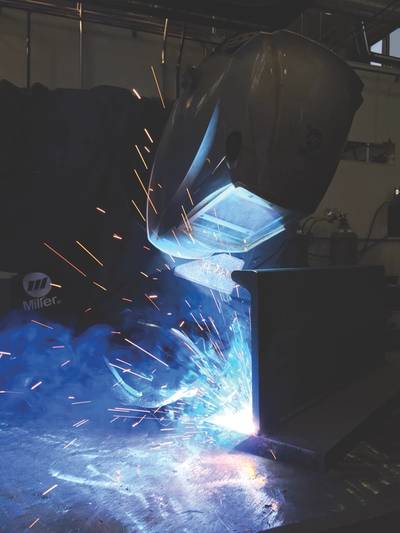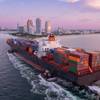Solving one problem can create another. Safety always comes first.
Amid competitive bidding, contract deadlines and the general drive to gain the best productivity and quality, welding operations in the shipbuilding industry face their own set of challenges. That’s especially true when it comes to welding primer-coated steel, a material prevalent for its ability to withstand atmospheric corrosion from sources such as saltwater.
Most primer coatings are zinc-based and used on steel that is between 70 to 120 ksi in strength (and sometimes higher). As a cost- and time-saving measure, shipbuilding operations employ this material to expedite the welding process — it eliminates the need for painting large portions of steel after the welds are completed. And while the coating serves a distinct protective function, it also makes it prone to issues like spatter and porosity during welding.
From selecting the right type and diameter of filler metal to employing proper techniques, it is possible to minimize the potential for these problems during welding — and to reduce downtime and cost for their associated rework.
Ahead of any such business matters, however, comes safety. The paint used for this material contains compounds that may release hazardous materials into the air when heated, including chromium, lead and tin, in addition to the zinc. As a result, the heat from the arc may cause paints to give off unsafe amounts of gases like carbon monoxide and carbon dioxide. They also give off zinc oxides, which are formed when zinc vaporizes from the weld pool. These gases are especially risky in confined work areas or those with poor air movement. Welding operators should always take proper safety precautions according the SDS (Safety Data Sheets) and Occupational Safety and Health Administration (OSHA) guidelines.
Recommended Techniques
Porosity is one of the biggest pitfalls when welding primer-coated steels due to the primer’s zinc content and its inability to burn out of the weld pool when the welding operator establishes an arc. Using travel speeds that are too fast can increase the opportunity for porosity and it can also result in poor tie-in at the weld of the toes. So what can be done?
One option is to remove the primer coating, but that is rarely a viable approach from a productivity standpoint; it causes additional downtime not only for the removal, but also for painting again after the weld is completed. Still, some companies may prefer this method.
Another option is to tandem weld on a dual-sided joint, employing two operators welding on opposite sides at the same time or using an automated process with two welding heads or two individual robots. In both cases, welding both sides can help to push the zinc impurities from the weld. In the case of a semi-automatic operation, it is common for end users to weld 3 or 4 inches ahead of the other welding operator to prevent zinc oxide gases from becoming entrapped in the puddle and solidifying as porosity.
Adjusting travel speed and voltage is another means to minimize issues when welding primer-coated steel. Because the primer often makes the weld pool sluggish, traveling too fast when welding can result in poor tie-in at the toes of the weld. Welding operators typically need to change their voltage and wire feed speed to accommodate for the coating. A lower voltage — about 5 to 7 percent less than when welding non-coated carbon steel — forms a tighter and/or more biting arc that is capable of burning the zinc out of the weld pool more readily. A slower wire feed speed is often necessary to compensate for the slower travel speed that accompanies this lower voltage. It is also important to note that the slower an operator goes, the more convex the weld bead may be, which may or may not be a factor in a given application.
Finally, the gun angle a welding operator uses in a manual operation can also help when welding primer-coated steel. Depending on the travel speed, using a slight angle, between 0 to 15 degrees, can help dig into the weld joint and create a tighter arc to weld through the primer.
Selecting a Filler Metal
When selecting a filler metal for welding primer-coated steel, it is important, first and foremost, to choose one specifically formulated to be tolerant of welding through primer or other such coatings. Contact a trusted filler metal manufacturer for the best recommendation. That said; flux-cored wire is often an ideal option for welding primer-coated steel. The flux inside of these wires often contains scavengers that are good at collecting impurities like zinc that compile in the form of slag after each pass. This slag must be chipped or otherwise removed, however, in between each pass and after welding.
Traditional flux-cored wires with an American Welding Society (AWS) T-1, T-9 or T-12 designator — for example, E71T-1C H4, E71T-9C H4 and E71T-12C H4 — can be used for a primer-coated welding application due to their excellent chemical and mechanical properties. The T-1 and T-9 wires have rutile slag, a feature known for being easier to operate. T-9 and T-12 wires have similar impact properties, such as a minimum of 20 foot-pounds at -20 degrees Fahrenheit, while a T-1 wire offers a minimum of 20 foot-pounds at 0 degrees Fahrenheit. T-9 and T-12 wires are typically best when welding primer-coated paint for ships that will encounter extremely cold or even arctic temperatures.
Wires with a “J” classification, such as E70T-1C/-9CJ H8 are also very well suited for welding primer-coated steel on ships encountering arctic temperatures, as these provide excellent low-temperature impact strength — a minimum of 20 foot pounds at -40 Fahrenheit.
Flux-cored wires with a T-5 designator are another option but can be a bit more difficult to operate due to their basic slag system. The benefit of using these wires, however, is that they provide excellent mechanical properties. Some of these wires available in the marketplace are also unique in that they can be operated on electrode negative or electrode positive, an added versatility depending on the application.
Electropositive welding (DCEP) provides better penetration while electronegative welding (DCEN) increases deposition rates. During DCEN, the process provides approximately 2/3 of the heat to the filler metal and 1/3 to the base material, which also helps control heat input and distortion.
T-5 wires offer impact values at a minimum of 20 foot-pounds at -20 degrees, similar to T-9 and T-12 products. T-5 wires also have a high capacity for absorbing oxygen so there is less risk of this atmospheric contamination.
Metal-cored wire can also collect impurities like zinc from primer-coated steel but is not quite as well suited for this application as flux-cored wire. One drawback to using metal-cored wire in this application is the manner in which it operates. This wire commonly uses a spray transfer mode, which requires using higher voltage. While that is a benefit in most welding applications — it produces less spatter and welds faster — when welding primer-coated paint, it is a disadvantage because it won’t help remove the zinc from the weld pool as well. Also, metal-cored wire is limited to flat and horizontal welding, due to the fluidity of its weld pool, unless paired with a power source that is capable of pulse welding; it can then be used out of position.
Minimizing Overexposure
- Most importantly, primer-coated steel can expose welding operators to fumes and gases during the welding process. Steel coatings and paints often contain materials that can cause harmful overexposure when breathed. As a result, the joining of some coated steel requires special types of ventilation and, in some cases, for welding operators to wear a respirator for optimal safety. Safety tips to consider – taken directly from the Safety and Health Fact Sheet No. 34, April 2014, American Welding Society – when welding primer-coated steel include:
- Always refer to the SDS for the type of material being welded.
- Be certain that there is adequate ventilation to control the weld fume and keep any contaminants below the Permissible Exposure Limit (PEL) set forth by OSHA and the TLV guidelines provided by the American Conference of Governmental Industrial Hygienists (ACGIH).
- Monitor air quality in areas where welding of primer-coated steel occurs. A certified industrial hygienist can perform this task.
- Consider the use of additional personal protective equipment such as a purified air powered respirator (PAPR).
- Train welding operators to keep their head out of the weld plume when welding.
-
The Author
Kevin Trick is Applications specialist at CWI, Hobart
(As published in the November 2016 edition of
Marine News)













